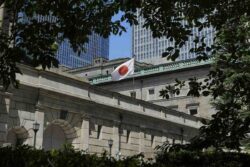
Kate, 10, holds her stuffed capybara, named Capi. “I feel happy and good,” she said of being back in Bucha after fleeing with her mom and brother earlier in the war.
12:06 JST, April 1, 2023
BUCHA, Ukraine – After Russian forces rampaged through this suburb of Kyiv last year and Anna, now 10, hid in a neighbor’s basement, she sought solace in her stuffed fox, Foxy, and cat, Vatka.
Vlada, 9, fled with her mom to Spain – carrying Octopus, her blue and pink octopus toy, a gift from her sister, with her.
Kira, also 9, clung to Basik, a gray stuffed cat her mom gave her after they fled Bucha with her older brother, separating them from their dad who stayed behind.
For the past year, these fourth-graders from the once idyllic town where Russian soldiers executed many civilians have withstood the toll of an adult war.
For the children in Bucha and throughout Ukraine, plush animals, security blankets and other comfort items have served as lifelines amid the chaos, especially for those who escaped taking only what they could carry.
Such precious belongings are now being slowly collected by the War Childhood Museum, a project dedicated to documenting the experiences of children raised in war by cataloguing and displaying their most personal memories and possessions.
The museum, which is based in Bosnia, is planning to add to its Ukrainian collection – now made up of around 150 toys, books and other ephemera mainly donated by children who, since 2014, had survived the Russian-backed separatist war in the country’s east.
By preserving children’s mementos and memories of war, the project has been able to document the individual and shared experience of growing up in a conflict zone.
Some of the museum’s irreplaceable modern artifacts – a stuffed penguin, a plastic horse and carriage, and a cardboard cat – are stored in an enormous metal safe in an office in Kyiv. Others are in a secret location in the Western city of Lviv, where they were relocated in a rush last year when staff feared the collection could be destroyed as Russian forces advanced on Kyiv.
The oral histories the museum collects, paired with a donated item from each child, challenge the idea that children only bear passive witness to conflict – offering young people the agency to reflect on how they managed life during war.
More than 400 children have been recorded killed and more than 800 wounded in Ukraine since Russia launched its invasion last February, although the true toll is probably far higher. Some were schoolmates of the fourth-graders in Bucha, murdered alongside many parents in the community. Among them were Katya, from 10th grade, who died when Russian forces struck her family’s car as they tried to escape, and Vanya, a ninth-grader shot by Russian snipers as he tried to crawl to safety. He was killed, his school principal suspects, “because he was a tall, beautiful boy” and the Russians “may have thought he was a man.”
As the war in Ukraine continues to rage in the country’s east and south, it is too soon for many kids to part with their comforting items or to talk in-depth about their experiences. Even children living far from the front lines face regular air raid alerts that send them running for cover. Others have family and friends fighting or living in the combat zone.
The museum’s researchers are treading carefully, and have interviewed just 11 children since February last year: five in the northeast city of Kharkiv, five living abroad in Poland and one, by video chat, in Spain. Two other researchers are now documenting the stories of Ukrainian refugees in Germany.
“We don’t want to talk to kids who are … still coping” with the most extreme circumstances, said Svitlana Osipchuk, 37, project director of the museum’s Kyiv branch. Participating children, she said, should tell their experience “as a past story.”
Museum staff create a file for each child they interview. The child’s donated item is then given a unique identification number, wrapped in protective paper and handled with gloves.
Only a handful of people know where exactly the full collection is stored in Lviv and only five know the passcode to the safe in Kyiv. Items from the collection have been displayed in exhibits in Kyiv and Kherson, in Ukraine, in Sarajevo, and soon in Bucharest.
When children offer a toy or book for the collection, Viktoriia Nesterenko, 30, a Kharkiv-based researcher for the museum, tells them: “‘Your pain is in this object and this object will be in a museum,'” she said. “‘Your pain is here. Not in you, but here.'”
“When children tell the full story they are healing themselves,” she said.
Many Ukrainian children are still learning how to tell theirs.
At School No. 4 in Bucha, a year after the Russian retreat, signs of war are still everywhere. The basement is used as a bomb shelter. One gymnasium has been transformed into a volunteer hub.
Administrators replaced the shrill school bell – too similar to air raid sirens – with music. One hall on the first floor is now home to a “Memory Wall” honoring students and alumni killed during the Russian occupation last year or on the front lines elsewhere in the country.
Fourth-grade teacher Ina Makariva, 60, wept as she described how the children in her class had been forced to mature.
These students fled at different points in the war – some under intense shelling, others before Russian forces advanced. Many have since returned home, but some, joining the class on Zoom, are still abroad. Their teachers say they aren’t the same.
“The students even learned the difference between kinds of weapons,” Makariva said. “They are changed. They are much older. They became much more serious.”
“It’s like a line appeared,” she added. “There was childhood on one side – and all of a sudden they grew up.”
Sitting in the front row, 9-year-old Kira clutched Basik, the cat, and her other stuffed animal, Brut, a dog. Both were dressed in baby clothes she took from a volunteer center where her dad had been working. But a month ago, he was deployed as a soldier for the first time. She said she didn’t know where he was – only that they hadn’t been able to talk as much as before.
This separation has been especially hard; her dad is the only one she allows to tuck her in at night.
A few days later, she got a welcome surprise when her dad, Viacheslav Kryvitskiy, 40, was able to briefly return home – offering the family some rare time together before he went back to his new post.
Sitting around their kitchen table, the family took turns cuddling their guinea pig and puppy – acquired shortly before Kryvitskiy was deployed – and sharing stories from the early days of the war.
Kira’s mom, Tetiana Kryvytska, 40, recalled how she drove the kids west last February, relying on strangers for help. She soon lost contact with her husband, who stayed behind to volunteer in Bucha.
When asked if, during the month apart, he had ever come face-to-face with Russian soldiers, Kryvitskiy glanced at his wife. Her eyes widened. He had never told his family this story.
One day, he said, he and other volunteers went looking for bread. Russian forces had already started executing civilians, and outside a grocery store, they found the dead strewn across the street. Horrified, they tried to move one of the bodies. Then a Russian soldier appeared. “He cocked his gun at us and said: ‘Put it back,'” Kryvitskiy recalled, his voice cracking. They slowly backed away and returned to the hospital where they were based.
Even after all this time, he hadn’t wanted to burden his family with that memory.
Otherwise, the parents said, they have not tried to hide the horrible realities of war from Kira, or her brother, Nazar, who is 12 – even as they see how it has changed them. They watch the news. They tell the children they have an enemy. On a drive one day, Nazar asked his father: “Is this the street where the executions happened?” He told him it was.
At school, Kira’s classmates shared the words they think of when they reflect on life during wartime. They called out from their seats: “Sad.” “Terrible.” “War.” “Fear.” “Pain.” “Lost.” “Shelling.”
At home, her dad reviewed the list and said there was one more word he wanted to add: “Victory.”
"News Services" POPULAR ARTICLE
-

American Playwright Jeremy O. Harris Arrested in Japan on Alleged Drug Smuggling
-

Japan’s Nikkei Stock Average as JGB Yields, Yen Rise on Rate-Hike Bets
-

Japan’s Nikkei Stock Average Licks Wounds after Selloff Sparked by BOJ Hike Bets (UPDATE 1)
-

Japanese Bond Yields Zoom, Stocks Slide as Rate Hike Looms
-

Japan’s Nikkei Stock Average Buoyed by Stable Yen; SoftBank’s Slide Caps Gains (UPDATE 1)
JN ACCESS RANKING
-

Keidanren Chairman Yoshinobu Tsutsui Visits Kashiwazaki-Kariwa Nuclear Power Plant; Inspects New Emergency Safety System
-

Imports of Rare Earths from China Facing Delays, May Be Caused by Deterioration of Japan-China Relations
-

University of Tokyo Professor Discusses Japanese Economic Security in Interview Ahead of Forum
-

Japan Pulls out of Vietnam Nuclear Project, Complicating Hanoi’s Power Plans
-

Govt Aims to Expand NISA Program Lineup, Abolish Age Restriction

























